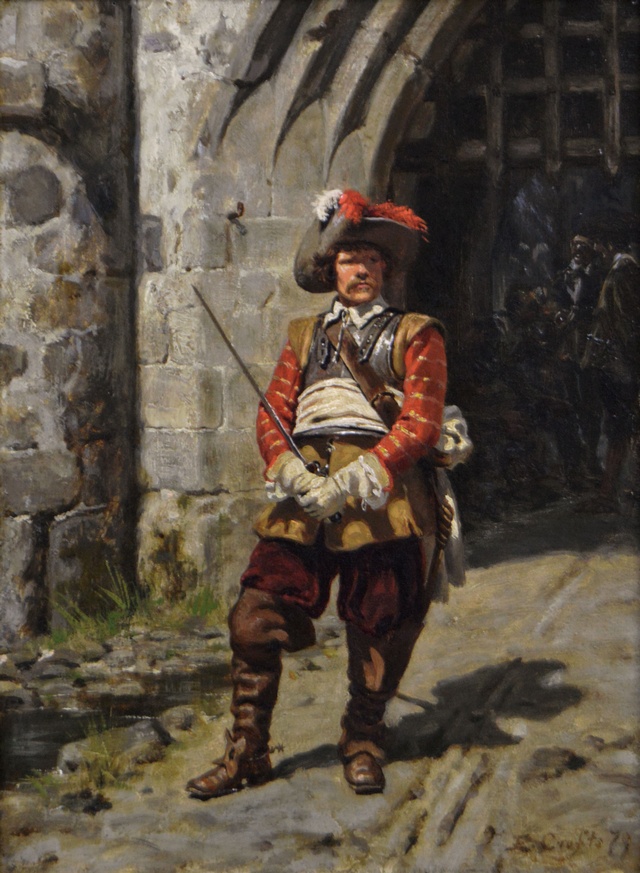Ernest Crofts
British, (1847-1911)On Guard
Oil on panel, signed & dated (18)79
A wonderful historical painting of a roundhead soldier standing outside a fortress by Ernest Crofts. The soldier is depicted wearing a back and breast plate over a red and yellow sleeved jacket tied with a sash around his waist. On his head, he wears a felt hat with red and white feathers and holds a sword in his hand. He is shown standing at the moated entrance of a fortified stone building with a portcullis. Beyond the raised portcullis, a group of soldiers can be seen in the shadows. The soldier’s uniform is typical of Cromwell’s famous ‘Ironside’ cavalry and indicates he is an officer, who, in Cromwell’s time would have earned his place based on merit rather than social status. The English Civil War was one of Crofts’s favourite subjects and he always tried to ensure that any uniforms, armour and weapons were accurately represented in order to bring authenticity to his works.
Ernest Crofts was one of the leading military and historical painters of the late Victorian era. He was born in Leeds on 15 September, 1847 to John and Ellen Crofts (née Wordsworth). His father was a solicitor who also set up a manufacturing business and acted as a local magistrate. His father’s wealth allowed him to attend Rugby School in Warwickshire. After leaving school, he studied art in London under Sir Arthur Bart Clay (1841-1928). However, he became interested in military subjects and decided to move to Dusseldorf in 1870 to study art with the German military artist Emile Hunten (1827-1902).
He married Elizabeth Wüsthofen from Dusseldorf in 1872 and a year later their only child, Elizabeth was born. The family lived at Adlerstrasse, Dusseldorf from where he made his debut at the Royal Academy in 1874 with ‘A Retreat: An Episode of the German-French War’. The painting also won him a silver medal the Crystal Palace show during the same year. During the following year he started painting historical military scenes beginning with the Waterloo campaign which he exhibited at the RA. Crofts’s attention to detail extended to building up a large collection of uniforms and accessories as well as visiting the battlefield sites of Waterloo and other wars. He also became interested in the English Civil War, painting many scenes and it was his Royal Academy picture of 1877 ‘Oliver Cromwell at Marston Moor’ that brought him critical acclaim.
He returned to England sometime during 1878, where he lived at 58 St Mary’s Terrace, Maida Vale in London. He was elected Associate of the Royal Academy on 19 June, 1878 and full Academician on 20 July 1896. During the 1880’s he kept a studio at Queen’s Road, St Johns Wood and by 1890 had moved to Grove End Road. In 1898, he became Keeper of the Royal Academy, remaining in the post until the year of his death. His position allowed him and his family to live at the Academy’s apartments at Burlington House. His interest in antiques and history also gave rise to his being made a Fellow of the Royal Society of Antiquaries in 1900.
Crofts died in London on 19 March, 1911 at Burlington House and was buried at the Kensal Green Cemetery. Examples of his work are held by Colchester & Ipswich Museums, Bristol Museum & Art Gallery, Dudley Museum, Leeds Art Gallery, Pannett Art Gallery, Sheffield Musuem, Towneley Hall Art Gallery, the Royal Academy of Arts Collections and the Walker Art Gallery.
© Benton Fine Art
| Presentation | The work is housed in its original gilt frame which is in excellent condition. |
| Condition | As with all of our original antique oil paintings, this work is offered in ready to hang gallery condition, having been professionally cleaned, restored and revarnished. |
| Image Size | 9.25 inches x 6.75 inches (23.5cm x 17cm) |
| Framed Size | 19.5 inches x 17 inches (49.5cm x 43cm) |



